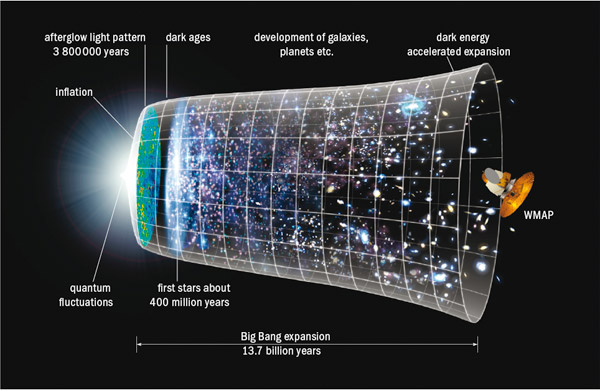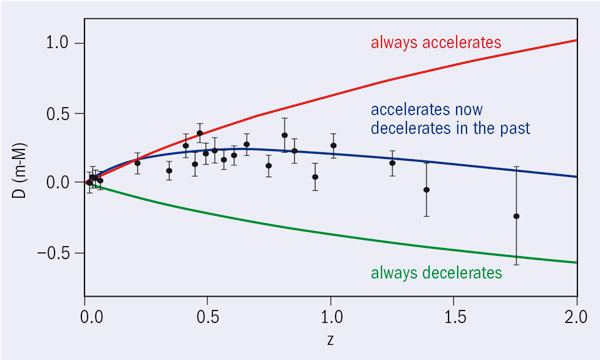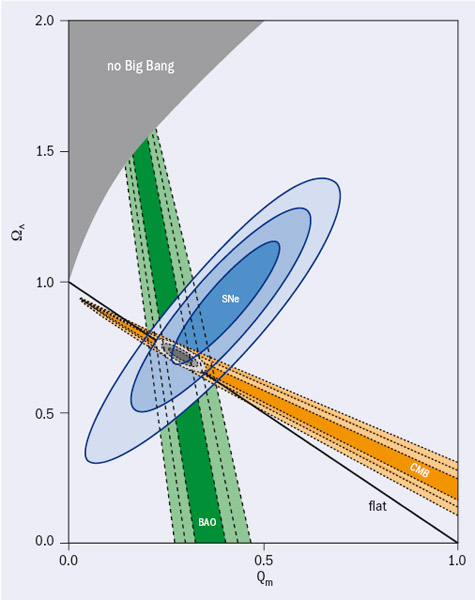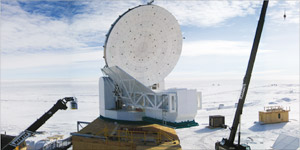Researchers gathered in Munich to discuss dark energy.
During the past decade a consistent quantitative picture of the universe has emerged from a range of observations that include the microwave background, distant supernovae and the large-scale distribution of galaxies. In this “standard model” of the universe, normal baryonic matter contributes only 4.6% to the overall density; the remainder consists of dark components in the form of dark matter (23%) and dark energy (72%). The existence and dominance of dark energy is particularly unexpected and raises fundamental questions about the foundations of modern physics. Is dark energy merely Albert Einstein’s cosmological constant? Is it a new kind of field that evolves dynamically as the universe expands? Or is a new law of gravity needed?
In the search for answers to these questions, more than 250 participants, ranging from senior experts to young students, attended the 3rd Biennial Leopoldina Conference on Dark Energy held on 7–11 October 2008 at the Ludwig Maximilians University (LMU) in Munich. The meeting was organized jointly by the Bonn-Heidelberg-Munich Transregional Research Centre “The Dark Universe” and the German Academy of Sciences Leopoldina, with support from the Munich-based Excellence Cluster “Origin and Structure of the Universe”. The goal of the international symposium was to gain a better understanding of the nature of dark energy by bringing together observers, modellers and theoreticians from particle physics, astrophysics and cosmology to present and discuss their latest results and to explore possible future routes in the rapidly expanding field of dark-energy research.

Image credit: NASA/WMAP Science Team.
Around 60 plenary talks at the conference were held in the central auditorium (Aula) of LMU Munich, with lively discussions following in poster sessions (where almost 100 posters were displayed) and during the breaks in the inner court of the university. There were fruitful exchanges between physicists engaged in a range of observations, from ground-based studies of supernovae to satellite probes of the cosmic microwave background (CMB), and theorists in search of possible explanations for the accelerated expansion of the universe, which was first reported in 1998. This acceleration has occurred in recent cosmic history, corresponding to redshifts of about z ≤ 1.
An accelerating expansion
Brian Schmidt of the Australian National University in Canberra gave the observational keynote speech. He led the High-z Supernova Search Team that presented the first convincing evidence for the existence of dark energy – which works against gravity to boost the expansion of the universe – almost simultaneously with the Supernova Cosmology Project led by Saul Perlmutter of the Lawrence Berkeley National Laboratory and the University of California at Berkeley. Adam Riess, a member of the High-z team, presented constraints on dark energy from the latest supernovae data, including those from the Hubble Space Telescope at redshift z > 1. This is where the acceleration becomes a deceleration, owing to the lessening impact of dark energy at earlier times (figure 1).
Both teams independently discovered the accelerating expansion of the universe by studying distant type Ia supernovae. They found that the light from these events is fainter than expected for a given expansion velocity, indicating that the supernovae are farther away than predicted (figure 2, p18). This implies that the expansion is not slowing under the influence of gravity – as might be expected – but is instead accelerating because of some uniformly distributed, gravitationally repulsive substance accounting for more than 70% of the mass-energy content of the universe – now known as dark energy.
Type Ia supernovae arise from runaway thermonuclear explosions following accretion on a carbon/oxygen white dwarf star and after calibration have an almost uniform brightness. This makes them “standard candles”, suitable as tools for the precise measurement of astronomical distances. Wolfgang Hillebrandt of the Munich Max-Planck Institute for Astrophysics presented 3D simulations of type Ia supernova explosions. It is still a matter of debate how standard these so-called “standard candles” really are. Their colour–luminosity relationship is inconsistent with Milky Way-type dust and, as Robert Kirshner of the Harvard-Smithsonian Center for Astrophysics mentioned, the role of dust is generally underestimated. Future supernova observations in the near infrared hold promise because, at these wavelengths, the extinction by dust is five times lower. Bruno Leibundgut of ESO said that infrared observations using the future James Webb Space Telescope will be crucial in solving the problem of reddening from dust.
As Schmidt pointed out, and others detailed in subsequent talks, measurements of the temperature fluctuations in the CMB provide independent support for the theory of an accelerating universe. These were first observed by the Cosmic Background Explorer in 1991 and subsequently in 2000 by the Boomerang and MAXIMA balloon experiments. Since 2003 the Wilkinson Microwave Anisotropy Probe (WMAP) has observed the full-sky CMB with high resolution. Additional evidence came from the Sloan Digital Sky Survey and 2-degree Field Survey. In 2005 they measured ripples in the distribution of galaxies that were imprinted in acoustic oscillations of the plasma when matter and radiation decoupled as protons and electrons combined to form hydrogen atoms, 380,000 years after the Big Bang. These are the “baryonic acoustic oscillations” (BAOs).
Dark-energy candidates
Eiichiro Komatsu of the Department of Astronomy at the University of Texas in Austin, lead author of WMAP’s paper on the cosmological interpretation of the five-year data, said that anything that can explain the observed luminosity distances of type Ia supernovae, as well as the angular-diameter distances in the CMB and BAO data, is “qualified for being called dark energy” (figure 3). Candidates include energy, modified gravity and an extreme inhomogeneity of space.

Image credit: Michael Turner, conference summary; Turner and Huterer 2007.
Although the latter approach was presented in several talks, the impression prevailed that the effects of dark energy are too large to be accounted for through spatial inhomogeneities and an accordingly adapted averaging procedure in general relativity. Komatsu – and many other speakers – clearly favours the Lambda-cold-dark-matter (ΛCDM) model, with a small cosmological constant Λ to account for the accelerated expansion. The dark-energy equation of state is usually taken to be w = p/ρ= –0.94 ± 0.1(stat.) ± 0.1 (syst.) with a negative pressure, p; a varying w is not currently favoured by the data. Several speakers presented various versions of modified gravity. Roy Maartens of the University of Portsmouth in the UK acknowledged that ΛCDM is currently the best model. As an alternative he presented a braneworld scenario in which the vacuum energy does not gravitate and the acceleration arises from 5D effects. This scenario is, however, challenged by both geometric and structure-formation data.
Theoretical keynote-speaker Christof Wetterich of Heidelberg University emphasized that the physical origin, the smallness and the present-day importance of the cosmological constant are poorly understood. In 1988, almost simultaneously with but independently from Bharat Ratra and James Peebles, he proposed the existence of a time-dependent scalar field, which gives rise to the concept of a dynamical dark energy and time-dependent fundamental “constants”, such as the fine-structure constant. Although observations may eventually decide between dynamical or static dark energy, this is not yet possible from the available data.

Image credit: Michael Turner, conference summary; Kowalski et . 2008.
Yet another indication for the accelerated expansion comes from the investigation of the weak-lensing effect, as Matthias Bartelmann of Heidelberg University and others explained. This method of placing constraints on dark energy through its effect on the growth of structure in the universe relies on coherent distortions in the shapes of background galaxies by foreground mass structures, which include dark matter. The NASA-DOE Joint Dark Energy Mission (JDEM) is a space probe that will make use of this effect, in addition to taking BAO observations and distance and redshift measurements of more than 2000 type Ia supernovae a year. The project is now in the conceptual-design phase and has a target launch date of 2016. ESA’s corresponding project – the Dark UNiverse Explorer – is part of the planned Euclid mission, scheduled for launch in 2017. There were presentations on both missions.
The first major scientific results from the 10 m South Pole Telescope (SPT) initial survey were the highlight of the report by John Carlstrom, principal investigator for the project. The telescope is one of the first microwave telescopes that can take large-sky surveys with precision. It will be possible to use the resulting size-distribution pattern together with information from other telescopes to determine the strength of dark energy.

Image credit: Bradford Benson.
Carlstrom described the detection of four distant, massive clusters of galaxies in an initial analysis of SPT survey data – a first step towards a catalogue of thousands of galaxy clusters. The number of clusters as a function of time depends on the expansion rate, which leads back to dark energy. Three of the detected galaxy clusters were previously unknown systems. They are the first clusters detected in a Sunyaev–Zel’dovich (SZ) effect survey, and are the most significant SZ detections from a subset of the ongoing SPT survey. This shows that SZ surveys, and the SPT in particular, can be an effective means of finding galaxy clusters. The hope is for a catalogue of several thousand galaxy clusters in the southern sky by the end of 2011 – enough to rival the constraints on dark energy that are expected from the Euclid Mission and NASA’s JDEM.
The conference was lively and social activities enabled discussions outside the conference auditorium, particularly during the lunch breaks in nearby Munich restaurants. The presentations and discussions all demonstrated that the search for definite signatures and possible sources of the accelerated expansion of the universe continues to flourish and has an exciting future ahead. The results on supernovae and the CMB have led the way, but there is still much to learn. In his conference summary, Michael Turner of the University of Chicago emphasized that “cosmology has entered an era with large quantities of high-quality data”, and that the quest to understand dark energy will remain a grand scientific adventure. Future observational facilities – such as the Planck probe of the CMB, which is scheduled for launch around Easter 2009, the all-sky galaxy-cluster X-ray mission eROSITA, ESA’s Euclid and NASA’s JDEM – are all designed to produce unprecedented high-precision cosmology results that will shed new light on dark energy.





